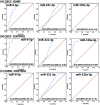Study of MicroRNA (miR-221-3p, miR-133a-3p, and miR-9-5p) Expressions in Oral Submucous Fibrosis and Squamous Cell Carcinoma
- PMID: 36684498
- PMCID: PMC9852399
- DOI: 10.1007/s12291-022-01035-x
Study of MicroRNA (miR-221-3p, miR-133a-3p, and miR-9-5p) Expressions in Oral Submucous Fibrosis and Squamous Cell Carcinoma
Abstract
Oral squamous cell carcinoma (OSCC) is one of the common types of cancer. Its progression follows a transition from oral potentially malignant disorders (OPMDs) such as oral submucous fibrosis (OSMF). Epigenetic modifiers, especially microRNAs (miRNAs), have an appreciable role in the regulation of various carcinogenic pathways which are being used as biomarkers. miRNAs may also be helpful in the differentiation of oral submucous fibrosis from oral squamous cell carcinoma. Three miRNAs, miR-221-3p, miR133a-3p, and miR-9-5p, were found differentially expressed in many cancers in the literature search supported by our preliminary database search-based screening. The literature and our functional enrichment analysis in an earlier study have reported these miRNAs to regulate carcinogenesis at various steps. In the present study, the expression of these miRNAs was examined in 34 histopathologically confirmed OSCC, 30 OSMF, and 29 control (healthy volunteers) human samples. There was a significant downregulation of miRNA-133a-3p in OSCC compared to OSMF and controls, whereas there was up-regulation in oral submucous fibrosis compared to controls. There was no significant difference in the expression of miR-221-3p between OSCC and OSMF, but an upregulation in OSCC compared to controls. miR-9-5p was also found upregulated in both OSCC and OSMF. Further, miR-133a-3p expression was negatively correlated with age, smoking, drinking status, and AJCC staging, whereas miR-9-5p expression was only positively associated with tobacco/ areca nut chewing. The ROC plots, logistic regression model generated, and the correlation between the expression of miR-9-5p and miR-133a-3p in blood and tissue suggests that these could be used as risk stratification biomarkers.
Keywords: Interactomics; Oral squamous cell carcinoma; Oral submucous fibrosis; Risk stratification biomarkers; microRNAs.
© The Author(s), under exclusive licence to Association of Clinical Biochemists of India 2022.
Conflict of interest statement
Conflict of interestThe authors declare that they have no conflict of interest.
Figures
References
-
- Warnakulasuriya S, Kujan O, Aguirre-Urizar JM, Bagan JV, González-Moles M, Kerr AR, et al. Oral potentially malignant disorders: A consensus report from an international seminar on nomenclature and classification, convened by the WHO Collaborating Centre for Oral Cancer. Oral Dis. 2020. - PubMed
-
- Dionne KR, Warnakulasuriya S, Zain RB, Cheong SC. Potentially malignant disorders of the oral cavity: current practice and future directions in the clinic and laboratory. Int J Cancer. 2015;136(3):503–15. - PubMed
-
- Shih Y-H, Wang T-H, Shieh T-M, Tseng Y-H. Oral Submucous Fibrosis: A Review on Etiopathogenesis, Diagnosis, and Therapy. Int J Mol Sci [Internet]. 2019 Jun 16 [cited 2020 Jul 22];20(12). Available from: https://www.ncbi.nlm.nih.gov/pmc/articles/PMC6627879/. - PMC - PubMed
LinkOut - more resources
Full Text Sources


